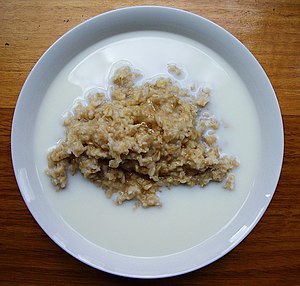Porridge: Difference between revisions
| Line 30: | Line 30: | ||
*[[Instant Quaker Oatmeal]] |
*[[Instant Quaker Oatmeal]] |
||
hello |
|||
==References== |
|||
{{Reflist}} |
|||
{{Refbegin}} |
|||
* [http://www.sfgate.com/cgi-bin/article.cgi?file=/chronicle/archive/2005/01/05/FDGCPAJ6AM1.DTL&type=printable Morning comfort - From Irish oatmeal to Chinese congee to Mexican champurrado, every cuisine offers steaming bowls of cereal to stave off winter's chill] |
|||
{{Refend}} |
|||
[[Category:Porridges|*]] |
|||
[[Category:World cuisine]] |
|||
[[Category:Scottish cuisine]] |
|||
[[ang:Brīw]] |
|||
[[ceb:Bouillie]] |
|||
[[da:Grød]] |
|||
[[de:Porridge]] |
|||
[[es:Porridge]] |
|||
[[eo:Kaĉo (manĝaĵo)]] |
|||
[[fr:Bouillie]] |
|||
[[id:Bubur]] |
|||
[[is:Hafragrautur]] |
|||
[[he:דייסה]] |
|||
[[nl:Pap (voedsel)]] |
|||
[[no:Grøt]] |
|||
[[nn:Graut]] |
|||
[[pl:Owsianka (potrawa)]] |
|||
[[pt:Mingau]] |
|||
[[ru:Каша]] |
|||
[[fi:Puuro]] |
|||
[[sv:Gröt]] |
|||
[[tl:Lugaw]] |
|||
[[tr:Yulaf lapası]] |
|||
[[zh-yue:餬]] |
|||
Revision as of 10:35, 17 March 2009
This article needs additional citations for verification. (July 2006) |

Porridge, or porage, is a simple dish made by boiling oats (normally crushed oats, occasionally oatmeal) or another cereal in water, milk, or both. It is eaten in a flat bowl or a dish. If made from cornmeal to which boiling water is added this can be seen as a variant of porridge, though these are more often described by regional/national variant names such as polenta and grits and are prepared and served according to special regional traditions. Oat and semolina porridge are the most popular varieties in many countries, other cereals used for porridge include rice, wheat, barley, and cornmeal. Legumes such as peasemeal can also be used to make porridge.
Gruel is similar to porridge but is much more like a drink; it has a very thin consistency and is made with water. It was served in Victorian workhouses as standard meals.
Porridge was a traditional food in much of Northern Europe back to antiquity. Barley was a common grain used, though other grains and yellow peas could be used, depending on local conditions. It was primarily a savory dish, with a variety of meats, root crops, vegetables, and herbs added for flavor. Porridge could be cooked in a large metal kettle over hot coals, or heated in a cheaper earthenware container by adding hot stones until boiling-hot. Until leavened bread and baking ovens became commonplace in Europe, porridge was a typical means of preparing cereal crops for the table.
In many modern cultures, porridge is eaten as a breakfast dish, often with the addition of salt, sugar, milk or cream. As the traditional breakfast of Scotland it is made with salt. Some manufacturers of breakfast cereal sell "ready-made" versions. Porridge is one of the easiest ways to digest grains or legumes, and is used traditionally in many cultures as a food to nurse the sick back to health. It is also commonly eaten by athletes training for their events, and it is done that way in road running.
In Scotland the art of porridge-making is competitive with the World Porridge Making Championships held annually in Carrbridge, Inverness-shire. The event is also known as the Golden Spurtle due to the winner receiving a gold-coloured trophy of a spurtle, which is a utensil used for stirring porridge. The contest is held in October each year[1].
See also
- Atheroma (meaning a "lump of porridge", from Athera, porridge in Greek) one of the three components of the atheromatous plaque
- Kasha (Russian word for porridge; an important part of Russian cuisine)
- Krentjebrij - a traditional Dutch porridge-like dessert
- Dalia, North Indian Breakfast item, primarily made of crushed (dulit) wheat grain boiled with water and preferably milk, considered easily digestible, nursing.[citation needed]
- Gofio made from roasted sweetcorn and other grains (e.g wheat, barley or oat). Gofio is still an important ingredient in Canary Islander cooking, and Canary Islander emigrants have spread its use to the Caribbean and all of Latin America. Gofio can be added to soups, stews, desserts, ice cream, sauces, and more.
- Mush
- "Pease Porridge Hot," a children's nursery rhyme
- The Three Bears, a children's story featuring porridge (also Goldilocks and the Three Bears)
- Ready Brek - a popular British brand of instant shredded oat cereal
- Instant Quaker Oatmeal
hello
